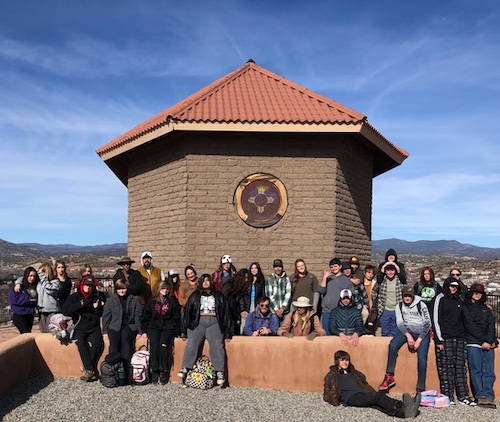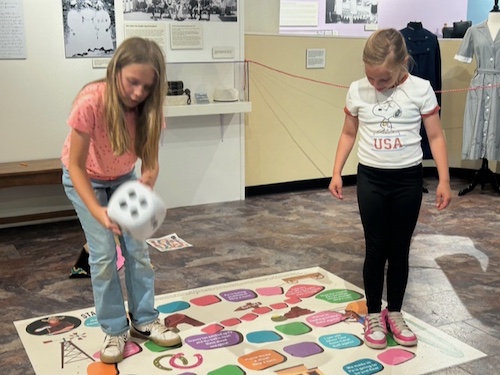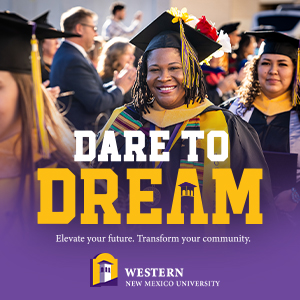 Students from Aldo Leopold Charter School are pictured at La Capilla, following a field trip to the Silver City Museum to learn about primary and secondary sources and the museum archives. Silver City -- Students from Cobre and Aldo Leopold high schools, as well as fourth-graders from Silver Schools and eighth-grade students from Cobre Schools, now have a better understanding of the rich ethnic and cultural diversity of the region after participating in the Silver City Museum's education programming.
Students from Aldo Leopold Charter School are pictured at La Capilla, following a field trip to the Silver City Museum to learn about primary and secondary sources and the museum archives. Silver City -- Students from Cobre and Aldo Leopold high schools, as well as fourth-graders from Silver Schools and eighth-grade students from Cobre Schools, now have a better understanding of the rich ethnic and cultural diversity of the region after participating in the Silver City Museum's education programming.
Since the fall of last year, Debaura James has been under contract with the museum to develop the curriculum, and work with local schools to bring it to hundreds of school children. James is a former teacher at Silver Schools, and a founder of Aldo Leopold High School.
"The objective of this curricula is to help kids better understand local history with all of the diverse ethnic and cultural identity groups that have lived in Silver City," she said.
The ethnic, culture and identity studies unit for high school students was developed with the help of Javier Marrufo, museum curator, and Renee Provencio, librarian at the Bayard Public Library, whose 2018 master's thesis, "Racial Segregation and Discrimination in Grant County," served as a foundation for the course. Museum Registrar and Collections Manager Ashley Smith and local historian Doug Dinwiddie, PhD, also contributed to the course development. Students have responded positively to the four-lesson curriculum, James said.
 Fourth-grade students Aizley Buzard (left) and Audrey Runyan from Cliff Elementary School rolled the dice in a game designed to teach area school children about women in health care, the subject of the Silver City Museum's current exhibit, "Healers and Heroines: Women and the Shaping of Local Health Care.""One student, who is part Apache, told me that this was the first time that anyone has talked about issues such as genocide, racism and cultural identity in class. "Another Hispanic student shared that in her mother's family, the person with the lightest skin was treated with privilege over the others, and how that gets internalized. We also talked about the Chinese and the Buffalo soldiers who left this area, no doubt in part because of how they were treated."
Fourth-grade students Aizley Buzard (left) and Audrey Runyan from Cliff Elementary School rolled the dice in a game designed to teach area school children about women in health care, the subject of the Silver City Museum's current exhibit, "Healers and Heroines: Women and the Shaping of Local Health Care.""One student, who is part Apache, told me that this was the first time that anyone has talked about issues such as genocide, racism and cultural identity in class. "Another Hispanic student shared that in her mother's family, the person with the lightest skin was treated with privilege over the others, and how that gets internalized. We also talked about the Chinese and the Buffalo soldiers who left this area, no doubt in part because of how they were treated."
Eighth-grade students - 100 of them - from both Snell and Aldo Leopold middle schools learned how to create oral histories with Javier Marrufo, whose work has culminated in a permanent exhibit on the museum's second floor, "Nuestra Voz: The Chihuahua Hill Story," the acclaimed collection of nearly 100 oral histories from Silver City's oldest neighborhood.
Students were taught how to interview their subjects, how to frame their questions, and how to record five-minute histories. They completed 50 oral histories through the course, and reported many positive experiences, including learning more about their parents, grandparents and other family members, understanding shared values, having empathy for their subjects or interviewees - even receiving some good advice for building a successful life.
"Leading with one's heart rather than one's head is one of the comments I got from a student's experience with the oral history," James recalled, "A few said they never really knew their grandfather before doing this project, and they felt really good about completing the process, and learning to listen and to appreciate another person's lived experience."
Fourth-graders from Silver Schools - a total of nine classrooms - took turns learning about the role of women in local health care by participating in a series of games and activities related to the museum's current exhibit, "Healers and Heroines: Women and the Shaping of Local Health Care."
The exhibit examines the questions, "What is health, what is health care, and how do we take care of each other?" The exhibit also explores the vital role that women have played throughout the history of health care in Grant County.
Fourth-graders watched a shadow puppet show about bullying - the topic prompted by the story of local personality Johnny Banks - then created and performed their own shadow puppet shows around the topic of bullying.
Riley Olsen, fourth-grade teacher at Cliff Elementary, said the curriculum was well-organized and easily accessible to her students, who seemed to really engage with the activities.
"As a teacher, it's so helpful to offer such hands-on learning opportunities about local history," she said. "It's really important that students have a deeper understanding of medical care in Grant County, and addressing a topic they haven't talked about, but that is very integral to a community, and to better understand the importance of women in health care and how their role has developed and evolved."
Two of her students, Aizley Buzard and Audrey Runyan, shared their opinions of the experience, saying, "It was nice to learn about all of the women who've worked in health care, and it was really cool to learn about some of the things that people used to believe," referring to part of the exhibit which illustrates antiquated medical ideas, such as using leeches to relieve illness, smoking as a cure for sore throats, and drilling holes into the skull to relieve headaches.
James, whose one-year contract with the museum ends soon, said she's enjoyed working with students again, and learning from colleagues.
"It really has been great to work with students again, and I've loved learning from my colleagues here at the museum. I've always loved learning about local history, and Javi in particular really helped fill in some of the gaps. I've also enjoyed working with some amazing volunteers, who've served as shadow puppeteers and help mentor the students. It's been a terrific experience, and the student feedback has been so positive. I'm truly grateful for this experience."
For more information about the Silver City Museum's educational programs, please contact
The Silver City Museum creates opportunities for residents and visitors to explore, understand, and celebrate the rich and diverse cultural heritage of southwestern New Mexico by collecting, preserving, researching and interpreting the region's unique history. The museum is nationally recognized through its accreditation by the American Alliance of Museums.
Museum admission is free, though a suggested donation of $5 helps support the museum's education programs, collections care and exhibitions. For more information, to donate or learn of volunteer opportunities please contact the museum at (575) 589- 0221 or visit the museum's website at www.silvercitymuseum.org.









